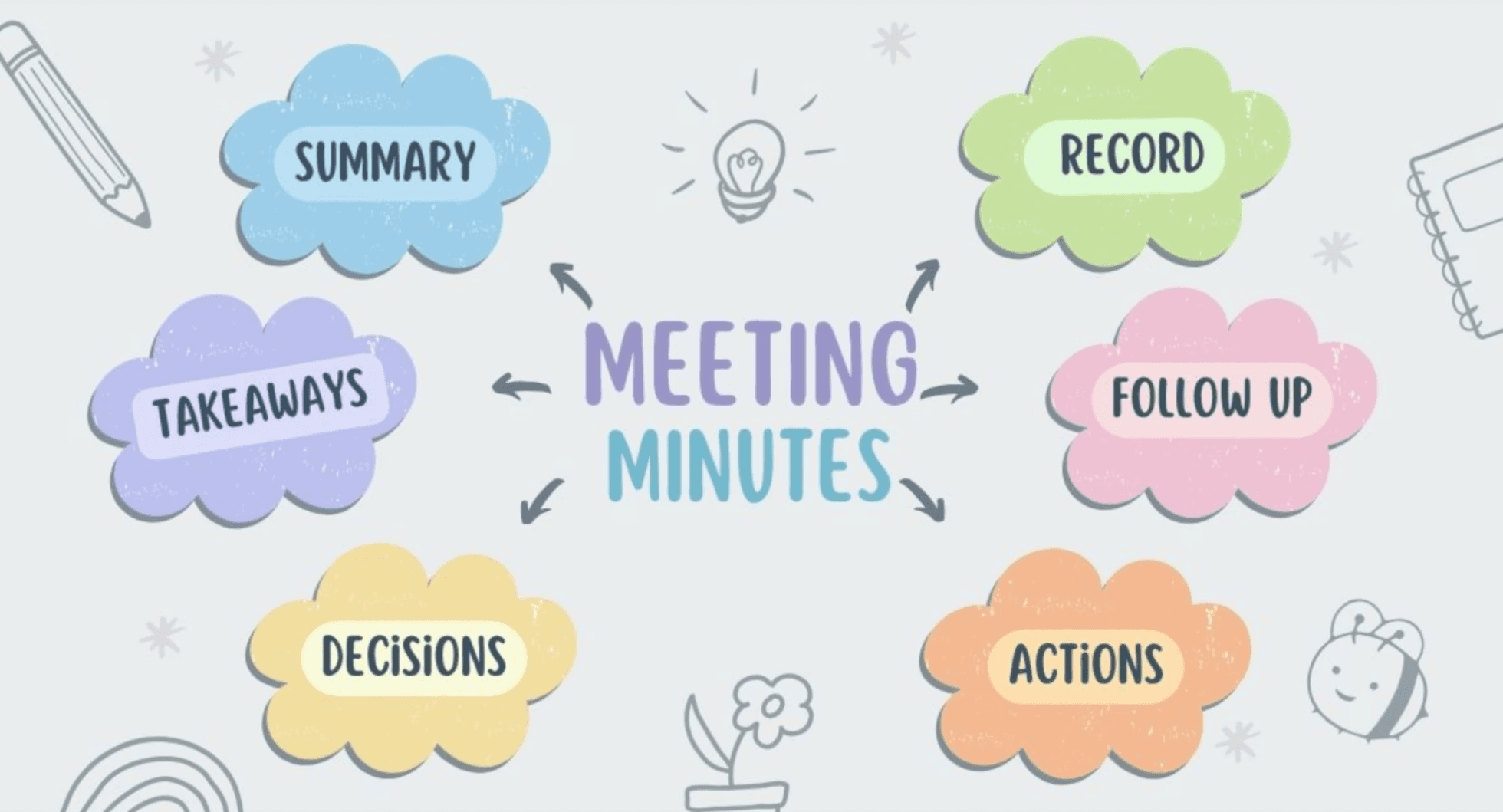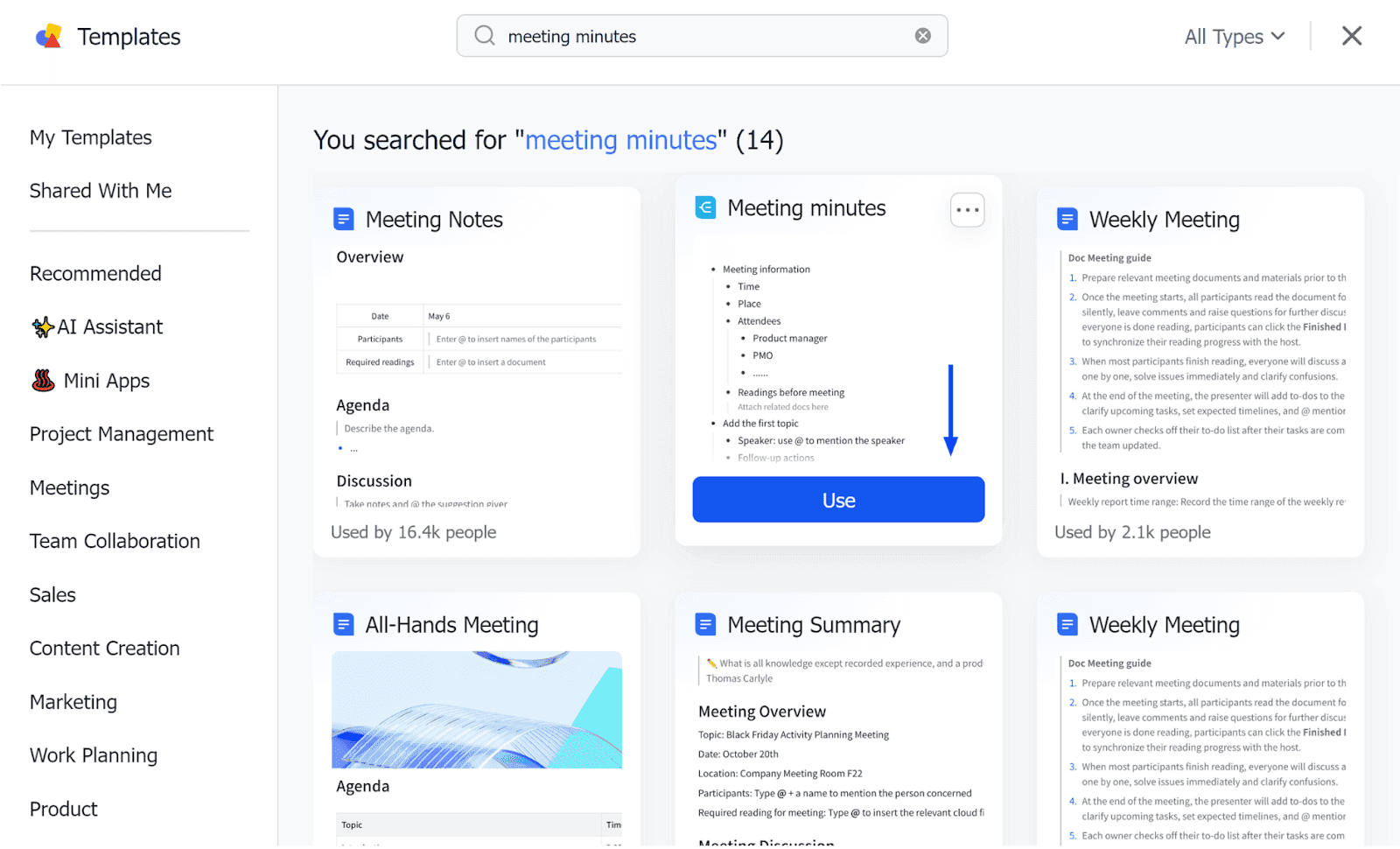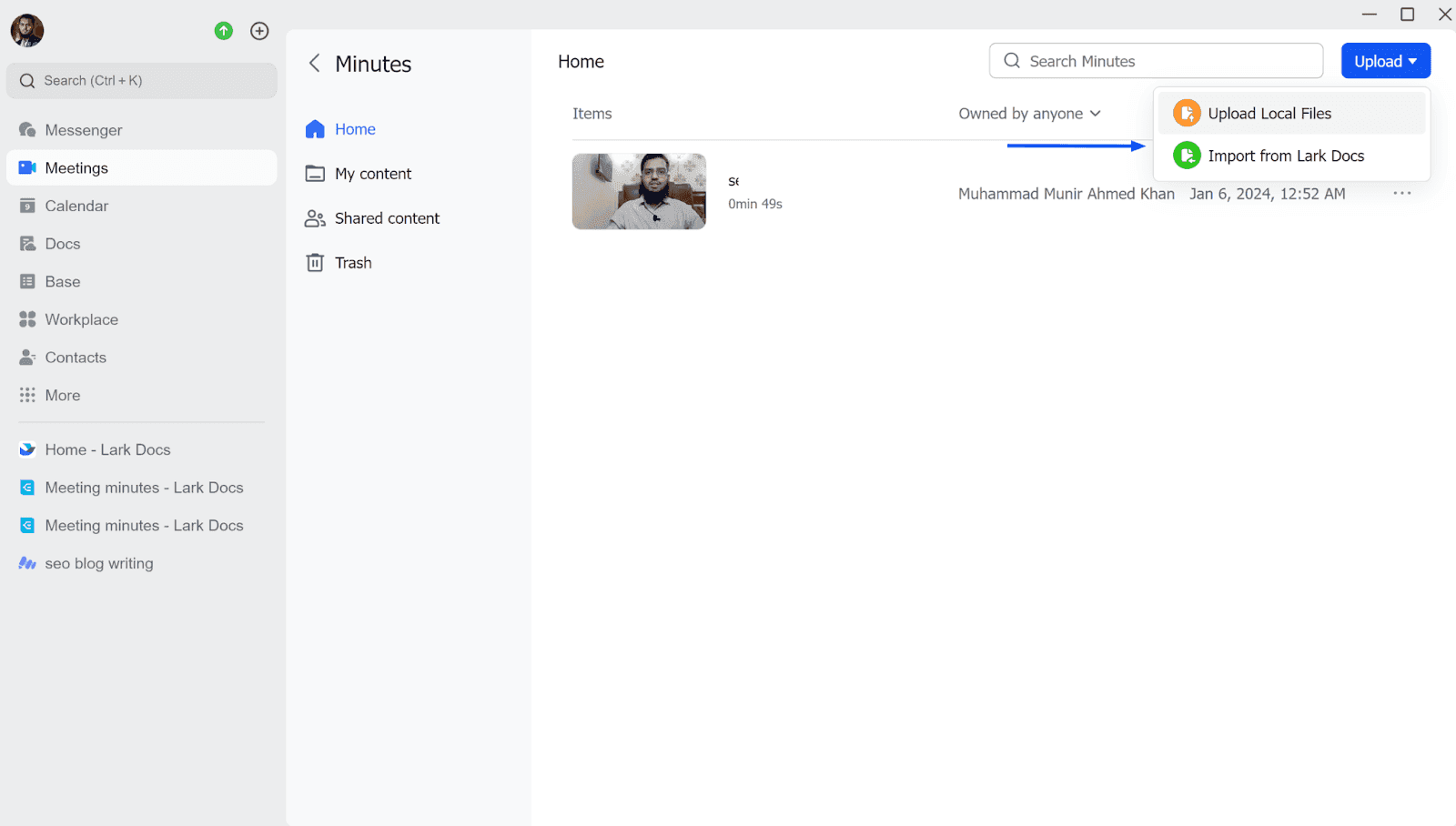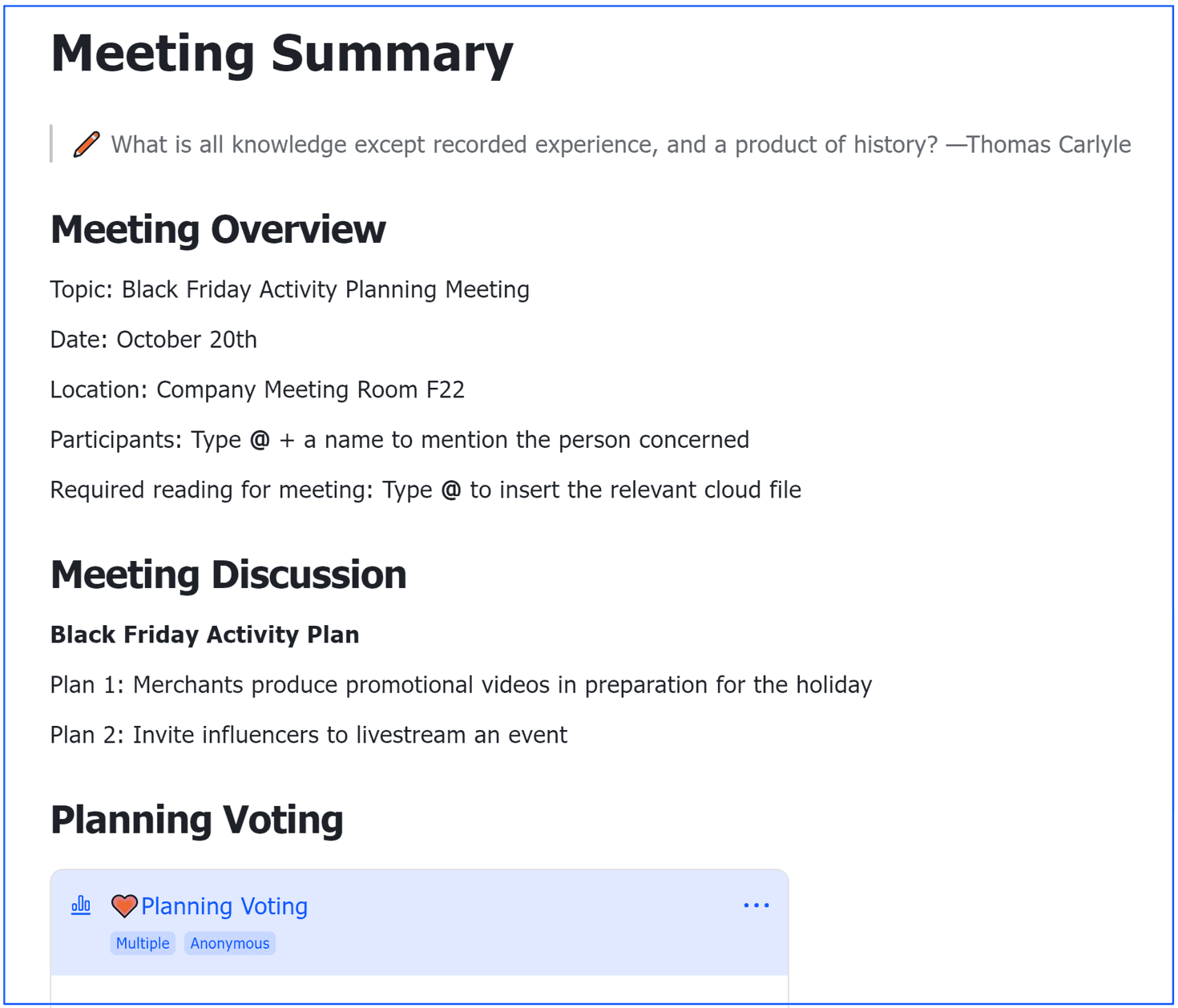Meeting minutes are more than just notes; they serve as the official record of discussions, decisions, and next steps during meetings. Mastering how to take meeting minutes is an essential skill that can transform team communication and accountability. Whether you're a seasoned professional or new to meeting management, learning practical strategies and having reliable templates at hand can make this task much easier and more impactful.
In this guide, we'll explore what meeting minutes are, why they matter, and walk you through a step-by-step approach to capturing meeting outcomes clearly and efficiently!
What are meeting minutes?

Meeting Minutes or Minutes of Meeting (MoM) are the written record of a meeting's activities, developments, and outcomes. These give a summary so that even absentees can understand what happened.
Don't get confused with the word "minutes," as it came from the Latin phrase "minuta scriptura," which means rough notes. It does not refer to recording every minute of the meeting.
It is recorded by the secretary or a specific member of the team who is referred to as a "Minute Taker." It requires a formal structure, key elements, and a proper method to convey the information, which is what we'll explore in the next sections of this post.
Meeting minutes vs. Meeting notes
Though people often use these terms as if they mean the same thing, meeting minutes and meeting notes actually have some key differences:
Formality and detail: Meeting minutes are formal, detailed records of the meeting designed to provide an official account. Meeting notes are more informal and usually less detailed.
Audience and distribution: Minutes are prepared for a wider audience and often stored for future reference or legal reasons. Notes are mostly for personal use or a small team’s quick reference.
Purpose and content: Minutes focus on recording decisions made, assigned tasks, and commitments. Notes capture ideas, reminders, or key points that may aid understanding or personal follow-up.
Usage timing: Minutes are polished and distributed after the meeting. Notes are often jotted down during or immediately after the meeting for quick recall. Minutes are polished and distributed after the meeting. Notes are often jotted down during or immediately after the meeting for quick recall.
Importance of taking meeting minutes
Meeting minutes play important roles in an organization. They serve multiple purposes, such as:
Remembrance: Anyone can recall what happened in the meeting by looking at the meeting minutes. They serve as a memory of all meetings that happened in the past.
Accountability: These official documents can help in team members' accountability and performance analysis.
Productivity: Meeting minutes enhance the productivity of a team by organizing and highlighting tasks, goals, developments, and other key aspects. They prevent confusion among team members.
Legal document: In case of any conflict, meeting minutes can be produced in courts and serve as a valid document and proof.
Future decisions: Meeting minutes keep track of past decisions and make future decision-making easier.
What you need to include in meeting minutes
Depending on the type of meeting, the meeting minutes items can differ. Here are the key and general elements:
Title of the meeting
Date, time, and location
Name of attendees and absentees
Purpose of the meeting
Agenda items
Action items
Decisions
Voting outcomes
Supported documents
Date of the next meeting
What to exclude from meeting minutes
When minutes become too detailed or include personal opinions, they lose professional value. Avoid including:
Verbatim statements or long-winded discussions
Personal comments or subjective interpretations
Irrelevant side conversations or off-topic remarks
How to write meeting minutes: A step-by-step guide
Mastering how to take meeting minutes starts well before the meeting even begins. Being prepared makes the note-taking process smoother and ensures you capture the most important information accurately.
We've encapsulated the process of writing effective meeting minutes in ten steps:
Preparation and planning
Pre-writing
Purpose
Initial note-taking
Writing meeting minutes
Resources and documents
Editing and revision
Getting approval
Translation
Sharing
1) Preparation and planning
The date of a meeting and agenda points are decided earlier, which leaves some time to plan and prepare for the meeting minutes. You can go through the agenda and previous meeting minutes.
Planning makes you ready for the situation and boosts your confidence. Say the purpose of the meeting is voting for president. You can plan meeting minutes based on the fact you need to note the attendees' votes.
Prepare an outline or template for the meeting minutes according to the meeting purpose and agenda. It has dedicated sections for the date, participants, agenda points, etc. It makes minute-taking quicker and easier.
2) Pre-writing
The pre-writing phase refers to writing a few known elements of the meeting minutes before the meeting starts.
Write the date, time, and location of the meeting. You can also add a list of participants in advance; if anyone is absent, you only need to add a strikethrough.
⭐Pro Tip: Write the initials or designations of participants to address them while taking notes.
3) Purpose
The purpose of the meeting should be clearly explained in the meeting minutes. It helps readers understand the objectives of a meeting at a glance.
Write the purpose in bullets to make it concise and easy to understand.
4) Initial note-taking
You should note important actions, decisions, and other key details to add later in the document.
You might forget some important developments once the meeting ends; that's why note-taking is essential. It helps you remember everything that happened and saves time finalizing the official document.
Taking effective meeting notes during the meeting requires focus and a good strategy:
Arrive early to get settled and review the agenda. Position yourself in a spot where you can clearly hear and see participants.
Use shorthand or bullet points. Writing verbatim isn’t necessary; focus on summarizing discussions, key decisions, and action items clearly and concisely.
Listen for decisions and action items. Highlight motions, votes, assignments, deadlines, and who is responsible for follow-through. These are the heart of meeting minutes.
Stay neutral and objective. Avoid including personal opinions or commentary. Your role is to accurately record what was said and decided.
Track attendance carefully. Note who is present, late, or absent so the record is complete.
Manage distractions and ask for clarifications. If you miss something important, don’t hesitate to ask politely for repeats or summaries during an appropriate moment.
You don't need to write the details of every minute. Focus on the meeting and only write what's essential. Write short phrases, bullets, acronyms, name initials, etc., to save time.
📕Further reading: How to Write Effective Meeting Notes
5) Writing meeting minutes
The best time to write meeting minutes is just after the meeting.
Fill in the actions, goals, decisions, deadlines, votes, takeaways, and other details in the template. Convert the notes you've taken during the meeting into formal meeting minutes.
Remember that meeting minutes are the summary; ensure concise and clear words. Use short phrases and highlight the important points.
6) Resources and documents
The participants of the meeting may present reports, research, and other documents. Once the meeting is over, request the resources and documents.
Without these documents, meeting minutes don't make complete sense. It is necessary to attach them to give a complete idea of the meeting to absentees and follow up without struggling.
7) Editing and revision
Review the minutes of the meeting and proofread everything to ensure accuracy. Pay attention to the details, such as format, grammar, typos, inconsistent structure, etc. If you’re looking to save time on similar tasks or need professional help, you might want to consider a service where you can pay to write my essay. This can help ensure your work is error-free and professionally completed.
You should remove the redundant and unnecessary items from the document. Make it presentable and easy to understand.
You can also ask a few attendees to go through the meeting minutes once and point out the details you've missed and mistakes. You might miss your mistakes, but others can point them out easily.
8) Getting approval
Getting approval from the board members, supervisor, or whoever is responsible makes the document credible. It can be used to resolve future conflicts and as a legal document in courts.
If they suggest any edits, make them and get their approval.
It might not be necessary for all meetings; however, it is a great way to ensure accuracy.
9) Translation
If participants of the meeting speak and understand different languages, it’s a must to translate meeting minutes and convey every piece of information accurately.
You might need professionals for this step; however, you can make it easier using an AI translation tool.
10) Sharing
The primary objective of meeting minutes is to share it with the participants, absentees, and relevant people to give them a summary of the meeting and maintain an official record.
Once you finalize the document, submit it to the official record if your organization has a separate database for important documents.
Share the meeting minutes via email, collaboration tool, or any other suitable medium. Make sure to control the access to selected persons. It ensures the confidentiality of your data.
Things to avoid
Waiting too long to write or send minutes
Omitting key decisions or action items
Including unrelated or off-topic discussions
Using overly complex language or jargon that can confuse readers
Make writing meeting minutes hassle-free with Lark
Lark Suite is a productivity super app for teams that includes apps for messaging, meetings, documents, calendars, tasks, emails, and more.
Using Lark Docs and Lark Minutes, we can effectively take meeting notes, create meeting minutes, and even transcribe meetings with AI.
Let's see how we can write meeting minutes and notes with Lark. First of all, you could create a free Lark account to follow along.
Write meeting minutes effectively with Lark Docs
Lark Docs offers meeting minutes templates and notes you can use to write your meeting minutes.
Open the Lark Desktop app. On the left, click "Docs."
On the Home page, click "Templates."

It'll take you to the Templates library. Search "meeting minutes," and you will see the available templates.

Hover over the template you want to use and click "Use." For example, you can start with the Meeting minutes template presented in the following picture.

Modify the template according to your meeting.

As you can see, we've selected a special template that can be converted into a mind map. Now click "Mind map."

Automate meeting minutes with Lark Minutes
Lark Minutes uses AI to convert audio and video into text. You can extract relevant information, change language, edit transcription, add comments, view notes, and do a lot more.
On the Lark desktop app, click "Meetings > Minutes."

Hover over the Upload button. You can upload a file from your computer or import it from Lark Docs.

If you want to upload a meeting recording from your desktop, please click "Upload Local Files" and select the file from your computer. Click "Submit."

Lark Minutes will upload the file and transcribe it through AI. Once it is ready, you'll see the video on the Home page. You'll also receive a notification once the transcription is available.
Click the video to open it. You'll see the AI-powered notes on the right.

Copy anything from the notes and add it to the transcription. You can also highlight anything in the transcript and add comments.

Once everything is ready, click the "Share" button. Add selected persons to give access or share through a link.

Best practices for effective meeting minutes
Taking clear, accurate, and actionable meeting minutes can be a game-changer for any team or organization. When done right, meeting minutes improve communication, enhance accountability, and keep projects moving forward smoothly. If you want to master how to take meeting minutes, here are some best practices to help you make every record count.
1. Prepare before the meeting
Good minutes start with good preparation. Review the meeting agenda and understand the topics that will be discussed. If possible, talk to the meeting organizer or chairperson to clarify key goals or expectations. Preparing makes it easier to anticipate important points and organize your note-taking effectively.
2. Use a consistent template
Using a predefined template designed for your meeting type (board, team, client, or committee) saves time and ensures you don’t forget crucial information. Templates guide you to capture essential details such as attendees, agenda items, decisions, action items, and deadlines. Consistency also makes minutes easier to read and reference later.
3. Focus on key points
During the meeting, concentrate on summarizing discussions, decisions made, and action items rather than writing down everything verbatim. Capture who said what only when necessary — mainly focus on outcomes and responsibilities. Clear, concise points keep your minutes focused and professional.
4. Use clear and simple language
Write your minutes in plain language that anyone can understand, including those who weren’t at the meeting. Avoid jargon or overly technical terms unless your audience is familiar with them. Short sentences and bullet points improve readability and help highlight important details.
5. Record action items precisely
One of the most valuable parts of meeting minutes is documenting action items. Clearly state what needs to be done, who is responsible, and the deadline. This clarity helps prevent misunderstandings and promotes timely follow-ups.
6. Review and edit promptly
Right after the meeting, take time to review your notes while everything is fresh in your mind. Correct errors, fill gaps, and organize content logically. Prompt editing improves accuracy and prevents you from losing important details.
7. Distribute minutes quickly
Send the finalized meeting minutes to all attendees and relevant stakeholders as soon as possible — ideally within 24 to 48 hours. Quick distribution ensures everyone stays informed and can act on their responsibilities without delay.
8. Store and organize minutes systematically
Keep your meeting minutes in a well-organized digital folder or document management system. Proper storage facilitates easy retrieval for future reference, audit, or compliance purposes.
9. Adapt and improve
Seek feedback from meeting participants occasionally on the clarity and usefulness of your minutes. Use their input to refine how you capture and share information, enhancing the overall effectiveness of your records.
Top 5 meeting minutes templates
Here are the top five meeting minutes templates designed by Lark for different meetings. You can use these templates on the Lark desktop app or browser.
1) Mind Map Meeting Minutes Template
This magical template converts your meeting minutes into a mind map that anyone can understand at a glance. Enter the details and click the button to convert it into a mind map. It summarizes everything in a flowchart or line diagram.
Key elements:
Date
Time
Place
Attendees
Readings before meeting
Topics
Speakers
Actions

2) Standard Meeting Minutes Template
It's an all-purpose meeting minutes template for board meetings, executive meetings, and large organizations.
Key elements:
Date
Participants
Required readings
Agenda
Discussion
Conclusion
Action items

3) Weekly Meeting Minutes Template
For weekly team meetings, departmental meetings, work progress meetings, and updates, this template is perfect. It keeps track of current and future goals.
Key elements:
Date
Members
Objectives
Member progress
Conclusion

4) Meeting Minutes Template with Voting Poll
If your organization needs to decide something through voting, use this meeting minutes template. Share the file with members so that they can vote anonymously. It makes your task a lot easier and maintains the confidentiality of votes.】
Key elements:
Topic
Date
Place
Participants
Discussion
Voting poll
Post-meeting tasks

5) Brainstorming Meeting Minutes Template
There could be many ideas in a brainstorming meeting, so noting them would be strenuous. Use this meeting template and note the ideas of all participants without any hassle.
The template can automatically convert all ideas into a mind map. It also includes a voting poll that gives instant results.
Key elements:
Time
Host
Note-taker
Participants
Objectives
Ideation
Discussion
Results
Voting and summary
To-do list

Conclusion: Master the art of meeting minutes
Writing effective meeting minutes is a skill that can transform the way your organization communicates and follows through on decisions. Clear, accurate, and timely minutes serve as a roadmap that ensures everyone stays on the same page, tracks responsibilities, and moves projects forward successfully. By preparing well, focusing on key points during the meeting, and promptly reviewing and distributing notes, you empower your team with transparency and accountability.
Whether you’re new to minute-taking or looking to refine your process, combining best practices with smart tools will elevate your effectiveness. Try Lark to simplify your workflow, enhance accuracy, and make every meeting count!
Frequently asked questions
What is the purpose of meeting minutes?
The purpose of meeting minutes is to create a formal record of what happened at the meeting. It summarizes the meeting for participants/absentees and can be used as a legal document in courts.
Are meeting notes called minutes?
Meeting notes are different from meeting minutes. These are taken during the meeting to remember what happened and help create meeting minutes.
Is it correct to say meeting minutes?
Yes, it is correct to say meeting minutes. However, the word "minutes" does not refer to time. It is derived from the Latin phrase "minuta scriptura," which means rough notes. It means Minutes of Meeting (MoM) or Notes of Meeting.
Table of Contents







